The story of mooncakes
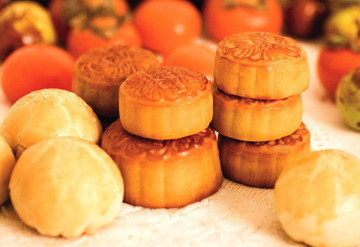
China’s traditional summer harvest season comes to a close at the time of year when the moon is closest to the earth. To celebrate, families would gather late at night to admire the moon and enjoy the bounty of the field, and of course to snack on mooncakes, the little cakes with a round shape that imitates the fullness of their namesake. With a thin crust of pastry and a thick gooey filling, usually of lotus seed paste (líanróng 莲蓉) or red bean paste (dòushā 豆沙), the mooncakes were traditionally so rich they had to be cut into small slivers and accompanied with sips of tea.
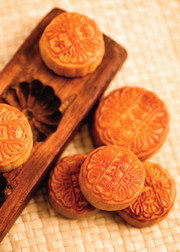 Making mooncakes the old-fashioned way requires a lot of practice and real stamina. For a cake with lotus seed filling, for instance, the lotus seeds must first be boiled, then mashed into paste. After being passed through a fine sieve, the paste is then dry-cooked (like stir-frying but without any oil) in a massive wok – a tough task, since the cook must stir the thick heavy paste constantly to prevent sticking and burning. As the paste caramelizes in the wok, the sweetness intensifies and the paste becomes heavy. When it’s done, a crust made of syrup, water, flour, and oil is wrapped around a ball of the paste, and the whole thing is stuffed into a wooden cake mold. Before baking, the cook will upturn the mold and bang it hard on a table – whack! The sticky, uncooked mooncake should fall out of the mold, clean and perfect and ready for the oven.
Making mooncakes the old-fashioned way requires a lot of practice and real stamina. For a cake with lotus seed filling, for instance, the lotus seeds must first be boiled, then mashed into paste. After being passed through a fine sieve, the paste is then dry-cooked (like stir-frying but without any oil) in a massive wok – a tough task, since the cook must stir the thick heavy paste constantly to prevent sticking and burning. As the paste caramelizes in the wok, the sweetness intensifies and the paste becomes heavy. When it’s done, a crust made of syrup, water, flour, and oil is wrapped around a ball of the paste, and the whole thing is stuffed into a wooden cake mold. Before baking, the cook will upturn the mold and bang it hard on a table – whack! The sticky, uncooked mooncake should fall out of the mold, clean and perfect and ready for the oven.
Nowadays, most mooncakes are mass-produced, and trendy new cakes are made in every style imaginable: unbaked mooncakes with a glutinous rice crust, ice cream mooncakes, jello mooncakes, even foie gras and champagne mooncakes! Edith Tan, nutritionist and proprietor of Taiwanese restaurant Alexander Creek Park, is one of the rare cooks who still likes to bake her own mooncakes. Her Taiwan-style version uses a tender pastry crust similar to a tart crust, and is filled with luscious jujube, red bean, or mung bean paste and sometimes a preserved duck egg yolk (also a symbol for the full moon). “Each region in China has its own version of mooncakes,” says Tan. “Cantonese moon cakes are the most popular, as they have a lovely chewy texture and the lotus seed filling is really smooth and moist. But in Taiwan, we like a lighter moon cake, so we use a crumbly pastry and, our favorite, mung bean paste filling.”
Mid-Autumn Rebellion
Legend has it that mooncakes played a pivotal role in Chinese history. Although not supported by historical documents, it’s widely believed that the Mid-Autumn Festival commemorates a Chinese uprising against the Mongol rulers of the Yuan dynasty. During this era of political instability, group gatherings were prohibited in order to prevent any planning for rebellion. To get around this, Han Chinese conspirators sent each other the message “Kill the Tatars on the 15th day of the eighth moon” written on slips of paper hidden inside mooncakes. What followed was a successful overthrow of the Mongol government on the Mid-Autumn Festival!
Chang’e’s Flight to the Moon
The beautiful immortal Chang’e and her husband Houyi the Archer lived in the heavens, which were ruled by the Jade Emperor. One day, the Jade Emperor’s nine mischievous sons turned themselves into nine fiery suns and began scorching the earth with their heat. To save the earth from harm, Houyi the Archer shot down eight of the nine suns using his bow and arrows, leaving just one sun in the sky. The Jade Emperor was extremely angry that Houyi had killed his sons, so he turned Houyi and Chang’e into mortals and banished them to live on earth.
Chang’e was very unhappy on earth and pined for her old life in the sky, so Houyi went on a perilous journey to get a magical pill that would make Chang’e and himself immortal again and let them return home to the heavens. This special pill was so powerful that Houyi and Chang’e only needed half of the pill each. However, Chang’e accidentally swallowed the entire pill all by herself and instead of returning to her heavenly home, she began to float all the way into space. Houyi could not bear to aim an arrow at his wife and shoot her down, and could only watch helplessly as Chang’e floated further and further away from him. Eventually, Chang’e floated all the way to the moon.
To this day, it is said, Chang’e lives on the moon, and spends her days longing for the Mid-Autumn Festival, when the moon comes close to the earth and lets her see Houyi again for a brief moment every year.
Fruits to Feast On
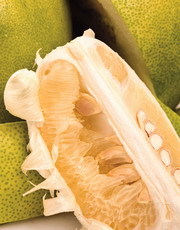
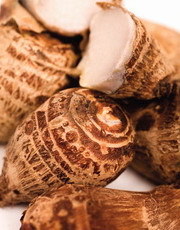
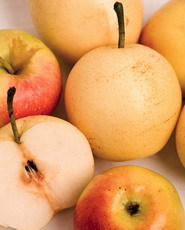
The Mid-Autumn Festival is a celebration of abundance, particularly of the abundance of fruit, which is at its most plentiful now.
Families feast on all kinds of round-shaped fruit – the spherical shape symbolizes the beauty of the full harvest moon and the unity of family brought together around a table. Here are some popular choices to try with your family this year.
Yoùzi 柚子 Pomelo
Lóngyǎn 龙眼 Longan
Shìzi 柿子 Persimmon
Yùtóu 芋头 Taro
Píngguǒ 苹果 Apple
Shuǐjīnglí 水晶梨 Shuijing Pear



